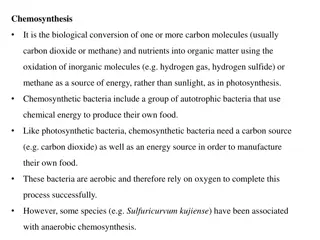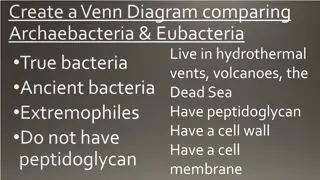Extreme Environments and Extremophiles: Surviving the Unthinkable
Extremophiles are organisms that thrive in extreme conditions such as high temperatures, acidity, salinity, and more. They have unique adaptations like extremozymes and can withstand harsh environments where life was once deemed impossible. Types include psychrophiles and Firmicutes, showcasing remarkable abilities to survive and even play important roles in various industries.
Download Presentation

Please find below an Image/Link to download the presentation.
The content on the website is provided AS IS for your information and personal use only. It may not be sold, licensed, or shared on other websites without obtaining consent from the author. Download presentation by click this link. If you encounter any issues during the download, it is possible that the publisher has removed the file from their server.
E N D
Presentation Transcript
EXTREMOPHILES: Thermophiles & Acidophiles
EXTREMOPHILES Organisms found living in extreme harsh environments. Word originated from Greek- Extremus + Philiawhich means extreme loving Definition: Extremophiles are organisms that have been discovered on earth that survive in environments that were once thought not to be able to sustain life. Most members of this group comes under the domain Archae. These include thermophiles, hyperthermophiles, thermoacidophiles, alkaliphiles, psychrophiles, halophiles, barophiles, radiation resistant bacteria and endoliths.
Adaptations Extremozymes- specialized enzymes that are highly stable. Can tolerate extremes of temperature, pH, salinity that would inactivate other enzymes. Important in industries because of this property.
EXTREME CONDITIONS Temperature pH Salinity Nutritional scarcities Absence of oxygen Radiation Pressure
TYPES Psychrophiles Temperatue range is -15 to 150C Also known as cryophiles. Have an optimum temperature of 150C orlower Isolated from Arctic and Antarctic habitats (90% ofthe ocean is 50C or colder) Also found in ice bergs, glaciers, snowfieldsetc Metabolism is quite normal at colder temperatures. Cell membranes-high levels of fatty acids whichremain fluid at colder temperatures. Proteinaceous antifreeze mechanism to protect thecell and DNA Some of them cause spoilage in refrigerated food materials. Eg: Arthrobacter spp, Psychrobacter spp,Halomonas spp, Pseudomonas, Sphingomonas
FIRMICUTES Gram positive, spore forming bacterial family that can survive desiccation and can survive extreme conditions. This group also is an example for extremophilic true bacteria (eubacteria). Plays an important role in the spoilage of beer, wine and cider. Eg: Helicobacterium spp, Mycoplasma, Clostridium spp.
Many members of the Family Firmicutes are also thermophiles. Eg: Bacillus stearothermophilus Recently, a DNApolymerase derived from these bacteria, Bst polymerase has become important in biotechnology. Bst polymerase- helicase like activity (making it able to unwind DNAstrands. Optimum functional temperature is 60-650C and get inactivated at temperatures above 800C
A thermophile is an organism a type of extremophile that thrives at relatively high temperatures, between 45 and 122 C (113 and 252 F). Many thermophiles are archaea. Thermophilic eubacteria are suggested to have been among the earliest bacteria. "Thermophile" is derived from the Greek: (thermotita), meaning heat, (philia), love. and Greek: Thermophiles are classified into obligate and facultative thermophiles: thermophiles (also called extreme thermophiles) require such high temperatures for growth, Obligate whereas facultative thermophiles (also called moderate thermophiles) can thrive at high temperatures, but also at lower temperatures (below50 C). Hyperthermophiles are particularly extreme thermophiles for which the optimal temperatures are above 80 C. Their membranes and proteins are unusually stable at these extremely high temperatures.
Thus, thermophilic enzymes because of their ability to withstand intenseheat. many important biotechnological processes use Many of the hyperthermophiles Archea require elemental sulfur forgrowth. Some are anaerobes that use the sulfur instead of oxygen as an electron acceptor during cellular respiration. Some are lithotrophs that oxidize sulfur to sulfuric acid as an energy source, thus requiring the microorganism to be adapted to very low pH (i.e., it is an acidophile as well as thermophile). These organisms are inhabitants of hot, sulfur-rich environments usually associated with volcanism, such as hot springs, geysers, and fumaroles.
THERMOPHILES Temperature loving organisms. Most members are Archae Grows in a temperature range of 55-1130C Mostly found in geothermally heated regions on earth viz., hot springs, hydrothermal vents etc. As they need extreme temperature, its very hard to study them under laboratory conditions. Also themselves (compost and garbage landfills). Eg : Cyanidium caldarium, Chaetomium thermophile that some members can produce heat by
Deinococcus-thermus is a small group of eubacteria which can thrive environmental hazards. Stains Gram positive (thick cell wall) but possesses an outer membrane, similar to the Gram negative cell wall. Several thermophilic bacteria comes under this group. It is the source of heat resistant enzyme- taq polymerase, which is well used in PCR. The enzyme is isolated from Thermus aquaticus.
Grand Prismatic Spring and Midway GeyserBasin- Yellowstone National Park, USA Source: Internet
CLASSIFICATION OF THERMOPHILES 1. Obligate thermophiles Also known as extreme thermophiles. Temperature range is 80-1220C. Membranes and proteins are unusually stable at these extreme temperatures. For this reason, most biological processes utilize thermophilic enzymes because of their ability to withstand intense heat. Many of this group can resist radiation too. Eg: Methanopyrus kandleri, can survive and reproduce at 1220C, Sulfolobus spp , Pyrococcus spp, Pyrodictium spp (optimum of 1130C)
Most of the members require elemental sulfur for growth. Anaerobic members use sulfur as electron acceptor instead of oxygen in cellular respiration. Some are lithotrophs that oxidizes sulfur to sulfururic acid as an energy source. Such organisms require a very low pH and hence known as thermoacidophiles. Inhabits regions associated with volcanic eruption viz; hot, sulfur rich, acidic regions such as hot springs, natural geysers, fumaroles etc .
HABITATS OFEXTREMOPHILES Hot spring situated in Atlanta, USA Courtsey: http://www.idahohotsprings.com/destinations/atlanta/atlanta_hot_ springs_01.jpg
Castle Geyser, Yellowstone National Park, USA Courtesy: http://upload.wikimedia.org/wikipedia/commons/4/49/Steam_Phase_eru ption_of_Castle_geyser_with_double_rainbow.jpg
Black smoker at a mid-ocean ridge hydrothermal vent
Thermoacidophiles Requires both high temperature and highly acidic environment for optimum growth. Preferred temperature range is 70-800C and have anoptimum pH range of 2-3. All the organisms discovered belongs to the DomainArchae, so far. They can thrive in acidous and sulfur richenvironments. Instead of cell wall, possesses a unique membrane composed of tetraether lipoglycan, which gives the unusual stability for the bacteria. Eg: Thermoplasma acidophilum and T.volcanium
Facultative Thermophiles Rare group of organisms that can live both in higher temperature and normal temperature are referred to as facultative thermophiles. These organisms can live at 200C, and have an optimum of 500C. Maximum temperature that they can survive is 600C. Eg: Bacillus flavothermus
Acidophiles or acidophilic organisms are those that thrive under highly acidic conditions (usually at pH 2.0 or below). These organisms can be found in different branches of the tree of life, includingArchaea, Bacteria, and also Eukaryotes. Archaea Sulfolobes, an order in the Crenarchaeota branch of Archaea Thermoplasmatales, an order in the Euryarchaeota branch of Archaea Acidianus brierleyi, A. infernus, facultatively anaerobic thermoacidophilic archaebacteria Haloarchaeum acidiphilum, acidophilic member of the Halobacteriacaeae Metallosphaera sedula, thermoacidophilic Bacteria Acidobacterium, a phylum of Bacteria Acidithiobacillales, an order of Proteobacteria e.g. A.ferrooxidans, A. thiooxidans Thiobacillus prosperus, T. acidophilus, T. organovorus, T. cuprinus Acetobacter aceti, a bacterium that produces acetic acid (vinegar) from the oxidation of ethanol. Alicyclobacillus, a genus of bacteria that can contaminate fruit juices. ]
ACIDOPHILES Microorganisms that lives in highly acidic environments are called as acidophiles. The pH range is 1-5. Some members that mainly found in the drainage of coal mines are able to oxidize sulfur into sulfuric acid. Mechanism of action is that they have a proton pump machinery to eliminate protons from the cytoplasm of the cell to maintain low pH. Eg: Pyrodictium, Picrophilus, Ferroplasma, Sulfolobus
Eukaryotes Mucor racemosus Urotricha Dunaliella acidophila Philodina roseola Acidophiles are acid-loving microbes. Most natural environments on the earth are essentially neutral, having pH values between five and nine. Acidophiles thrive in the rare habitats having a pH below five. Highly acidic environments can result naturally from geochemical activities (such as the production of sulfurous gases in hydrothermal vents and some hot springs) and from the metabolic activities of certain acidophiles themselves. Acidophiles are also found in the debris left over from coalmining. Interestingly, acid-loving extremophiles cannot tolerate great acidity inside their cells, where it would destroy such important molecules as DNA. They survive by keeping the acid out. But the defensive molecules that provide this protection, as well as others that come into contact with the environment, must be able to operate in extreme acidity. Indeed, extremozymes that are able to work at a pH below one--more acidic than even vinegar or stomach fluids--have been isolated from the cell wall and underlying cell membrane of some acidophiles.
Most mechanisms to pump protons out of the intracellular space in order to keep the cytoplasm at or near neutral pH. acidophile organisms have evolved extremely efficient Therefore, intracellular proteins do not need to develop acid stability through evolution. However, other acidophiles, such as Acetobacter aceti, have an acidified cytoplasm which forces nearly all proteins in the genome to evolveACIDstability. For this reason, Acetobacter aceti has become a valuable resource for understanding the mechanisms by which proteins can attain acid stability. Studies of proteins adapted to low pH have revealed a few general mechanisms by which proteins can achieve acid stability. In soxF most acid stable proteins (such as pepsin and the over protein from Sulpholobus abundance of acidic residues which minimizes low pH destabilization induced by a buildup of positive charge. acidocaldarius), there is an

































